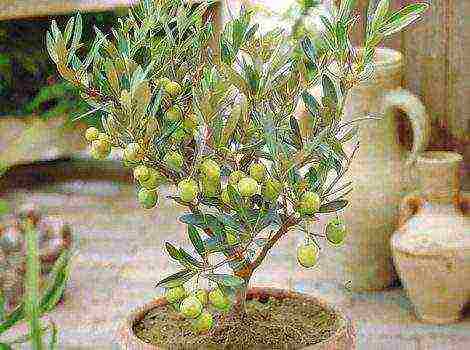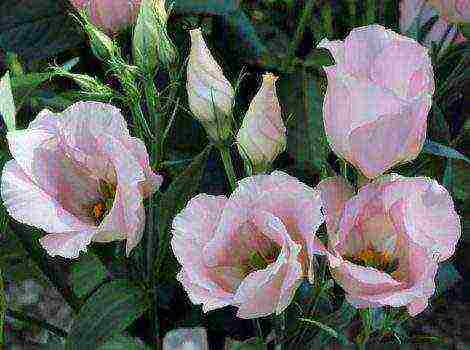Content
- 0.1 How to start breeding pigeons as a business?
- 0.2 How to determine the age of a pigeon?
- 0.3 Pigeon training
- 0.4 Breeding meat pigeons for slaughter
- 0.5 Breeding methods:
- 0.6 Profit from the pigeon business
- 1 How to build a dovecote and where to place it?
- 2 How to feed pigeons at home?
- 3 Hygiene of domestic pigeons
- 4 Diseases of domestic pigeons
- 5 How to tame a pigeon
- 6 How to breed at home?
- 7 Requirements for keeping birds
- 8 Video recording "Pigeons: where did it all begin?"

Finding a profitable and free sphere of entrepreneurship, in our time, is quite difficult. But, as they say, there are no impossible tasks. There are many examples when a hobby turns into a stable and highly profitable way of earning money. Breeding pigeons at home as a business is a field of activity that can provide you with a good profit with a skillful and competent implementation of the idea. In this article, we will take a closer look at the pros and cons of breeding pigeons at home.
How to start breeding pigeons?
Growing pigeons, as well as breeding parrots at home, may well become a promising and profitable business. But this type of business is quite specific, you need to be a professional in this field of activity, to understand all the nuances of breeding, keeping and raising pigeons. More often than not, pigeon breeding is a hobby rather than a business. Many people breed birds solely for pleasure, and at first do not perceive their activities as a way to generate income. And this is in vain, because you can really earn money on breeding pigeons. How? We will talk about this in this article.
Choosing a direction
Before starting to implement a business idea, you should decide on a direction. Pigeons can be bred for different purposes: for meat, for training, selling as pets.
- Breeding of meat pigeons (roman, king, strasser) - this breed of pigeons is intended for slaughter for meat. Birds of this breed are highly reproductive and gain weight rapidly. Pigeon meat is considered a great delicacy, it has useful properties and high taste. The cost of pigeon meat is very high, which makes this business area quite profitable.
- Breeding of Uzbek pigeons, Jacobins, blowers for decorative purposes. These breeds of birds are characterized by a beautiful color and are grown exclusively for decorative purposes. These pigeons are most often released at weddings and other events. The point of breeding is training the birds and renting them out.
- Growing pigeons for sports purposes. The most suitable breeds: Tula, Uzbek fighting, hryvnias. These birds are bred for participation in exhibitions and various sports competitions.
Related Videos Related Videos
How to start breeding pigeons as a business?
Before starting to implement the idea, study in detail the chosen field of activity, determine the profitability of the idea, the payback period. I recommend that you draw up a detailed business plan for breeding pigeons at home, in which all the important nuances of this way of earning will be indicated.
It is also necessary to study all the information about the rules of breeding, keeping, choosing the breed of birds, feeding rules, etc. In general, you should be aware of all the nuances.
How to choose a breed of pigeons for breeding?
If you have decided on the purpose of raising birds, then you can start choosing a breed and buying pigeons for breeding.
To start a business, you should buy young birds. In order to choose the right breed and acquire healthy chicks, you should have certain knowledge in this field of activity. If you are a beginner, I recommend seeking help from an experienced fancier.
Doves are monogamous birds that form pairs and remain faithful to each other. It follows from this that individuals need to be acquired in pairs. It is not difficult to calculate the male and the female, the couples coo among themselves, and the depths of the same sex are usually aggressively opposed to each other and can fight.
How to determine the age of a pigeon?
The average life span of these birds is about 15–20 years. But reproduction takes place only up to 10 years, after that, the birds practically lose their reproductive function, and if the offspring is born, then it is very weak and practically unable to survive.
Therefore, only young, purebred pigeons are suitable for breeding. You can determine the age of a bird by its paws and wax. At the age of five months, the blue reaches puberty and the wax becomes white. Over time, it increases in size, which allows you to determine the approximate age of the bird up to 3-4 years. After that, it is rather difficult to do it.
Rules for keeping pigeons at home
It is necessary to properly equip the room for keeping pigeons. Usually birds are kept in specially equipped nurseries or cages (poultry houses).
The cages in which the pigeons are kept must be spacious and clean, cleaning must be carried out constantly in order to avoid diseases.
Young birds should be kept away from older birds for some time. The same goes for birds of different breeds.
Pigeon training
If you breed pigeons for decorative purposes, then you should definitely devote a lot of time to their training.
Decorative pigeon breeds are bred exclusively for participation in special events, most often at weddings. Surely everyone has heard about the tradition of the bride and groom releasing pigeons after the wedding ceremony. Thus, you can make good money on this business.
Breeding meat pigeons for slaughter
Above, we have already noted the beneficial properties of pigeon meat. Therefore, if you decide to breed birds specifically for slaughtering for meat, you should study the important nuances of their nutrition.
Basically, the diet of pigeons consists of grain mixtures, the most suitable grain is barley. Also, birds need to be given vitamin products - grated raw vegetables and fruits.
In order for pigeons to gain weight quickly, they should be additionally fed with high-calorie foods: egg-pea, potato-pea porridge, and also add fat to food.
Do not forget about vitamins to maintain immunity. It is necessary to add calcium, iron, magnesium, phosphorus to food. You can buy special feed mixtures that are saturated with all the necessary vitamins, but they are quite expensive.
Related Videos Related Videos Breeding pigeons
Pigeons usually start breeding in early spring. By this time, the cages should be prepared, cleaning and disinfection of the premises where the birds are kept should be carried out.
Breeding methods:
- Naturally mating. Males look for females for themselves with the onset of bird breeding season and form pairs. The disadvantage of this method is that, thus, not the most successful couples can be formed, which ultimately lead to the birth of weak and unclean offspring;
- Inbreeding - a method of mating related pigeons in order to improve the purity of the breed;
- Mating of birds of similar appearance;
- Linear dilution. This option is based on an accurate determination of the inheritance of the qualities and consequences of mating by birds.
After mating, the pigeons begin to build a nest. The female lays eggs, which the birds incubate in turn, on average the whole process takes up to 4 weeks.
Business costs
The main financial cost is the purchase of pigeons. The cost of birds varies significantly depending on the breed. Ordinary white pigeons will cost you 2-3 thousand rubles, and for decorative or sporting breeds you will have to pay about 5000 rubles. Don't forget that all costs must be clearly defined in the business plan. How to compose it? As an example, you can see
business plan for breeding quail
.
Profit from the pigeon business
Your profit will depend on many nuances. First, from the choice of direction. For example, if your goal is to breed pigeons for meat, then it will take about six months to raise the birds and fatten them to the desired mass. The approximate cost of one carcass is about 500 rubles. But here, it is important to consider the distribution channel, which should be established in advance. This requires developing a competent advertising campaign.
For example, you can create your own website where you will offer your products or services for renting pigeons (if you are raising birds for decorative or sporting purposes). This will help you find clients and generate consistent profits.
If you liked the idea, then read about a similar type of income - raising chickens as a business.
I wish you well.
Rate the article -
(
6 voted. Rating: 4.83 out of 5
)
10.11.2017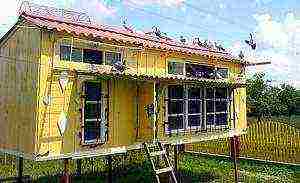
To be engaged in raising pigeons, these wonderful birds must at least be loved, because these birds are extremely graceful, loyal and quickly get used to people. It was not for nothing that it was the dove that brought Noah a green olive branch, as a good news, foreshadowing the end of the global flood.
Even in the Middle Ages, the dove was considered a symbol of the purity and innocence of a girl, therefore it was customary to release pigeons on the day of the wedding, since this bird even then personified love and peace.
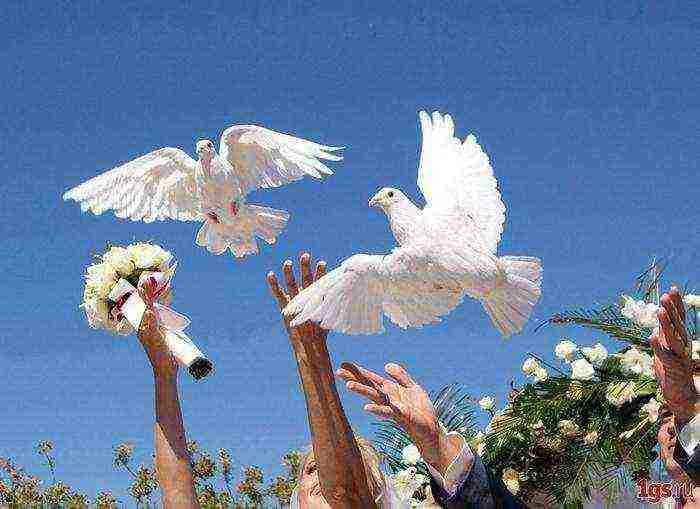
Choosing a breed for breeding pigeons
Initially, before purchasing birds, a pigeon breeder needs to clearly determine the breed in order to choose which birds to breed: wild or domestic.
With wild breeds, there is certainly more trouble, since wild pigeons are more demanding on the rules of care and are extremely sensitive to the conditions of keeping, because they love freedom and, accordingly, require a lot of free living space.
Domestic pigeons, on the other hand, are undemanding to the conditions of detention, tolerate captivity well and are absolutely undemanding in food.

Depending on the purpose of breeding, pigeons can be divided into three main categories:
· Flying birds. As a rule, different breeds of pigeons differ in flight patterns, and each variety has its own individual handwriting or "pattern", so many pigeon breeders choose one or another breed of "flyers" in order to observe the beauty of their flight.
· Sports birds, which are descendants of carrier pigeons and are bred for the purpose of participating in tournaments where the fastest individuals are determined.
· Decorative pigeons with an unusual exterior, color or plumage. Today in the world there are about two hundred species of pigeons with more than thirty varieties of color. Alas, decorative breeds are also very demanding in terms of keeping conditions.
It must also be said that many pigeons are raised for the purpose of eating them, because in fact, pigeon meat is not just edible, but considered dietary (one hundred grams of meat contains only 294 kilocalories). In appearance, it resembles the meat of wild birds, and as for the taste, the pigeon meat is sweet and goes well with fruits and berries.
Maintenance and care of pigeons
To start breeding pigeons, the first step is to take care of the arrangement of the dovecote in order to provide the birds with comfortable living conditions, therefore it is advisable to breed the birds in a specially equipped room (preferably with an aviary fenced in a cage), in which it is imperative to arrange an arrival window.
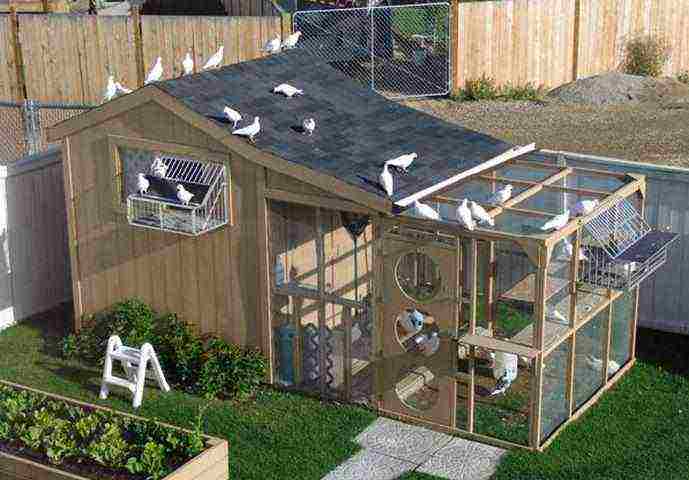
The dovecote should be warm, without drafts, while being able to conduct regular ventilation. It is necessary to ensure that, even in winter, the air temperature inside does not drop below ten degrees Celsius.
The room where the pigeons are kept should be kept clean and from time to time completely disinfected, otherwise the pigeons may become infected with infectious diseases.
At least once a week, the feeders should be thoroughly washed and cleaned, and the pigeon house should be kept free from rodents that could spread disease.
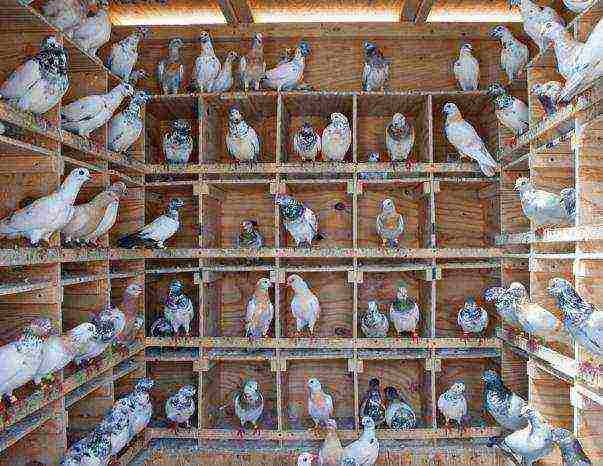
It is advisable to divide the room inside the dovecote into sections. The pigeon's cage should be deep enough for the bird to fit completely and be about twenty centimeters high and about forty centimeters wide.
For the convenience of birds, it is advisable to equip the entrance to the cell with a perch, and systematically clean the cells of droppings and debris.
Acquisition of pigeons
Usually pigeons are bred in pairs (female and male), but if they are bred solely for aesthetic pleasure, then, as a rule, the birds themselves will find a mate.
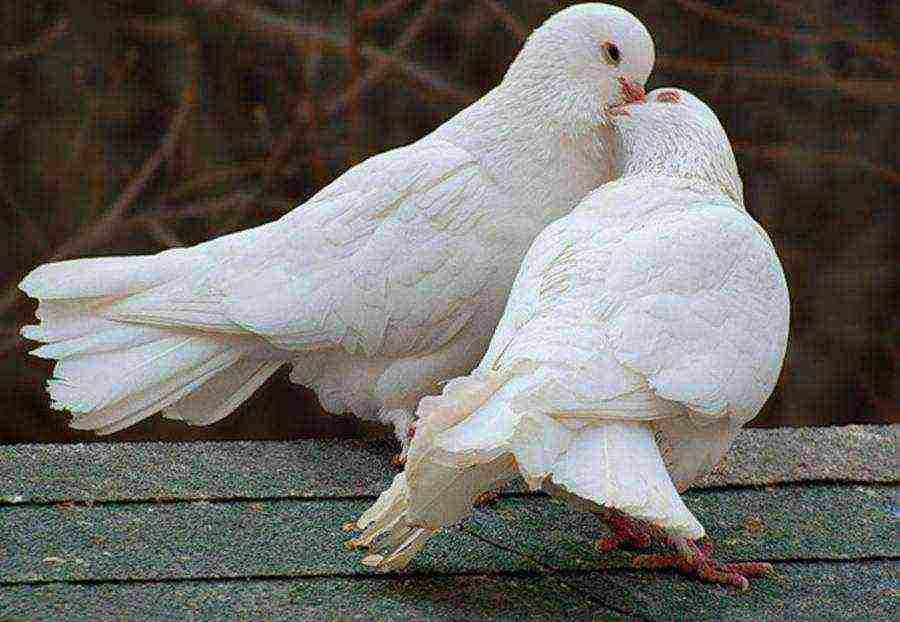
The male usually has a larger size and, during the mating season, performs dance "steps" around a potential partner. The resulting pair is easy to recognize by how friendly the pigeons are to each other. Formed couples spend all the time together, it is not for nothing that our people have a common noun: "behave like doves."
When choosing a pigeon pair, you need to pay attention to birds of medium build, trying not to take too large or too small. Pigeons should be clean, well-groomed, have smooth plumage without visible defects on the body (lameness, unnaturally protruding feathers, etc.). In addition, the birds must have a good appetite and good flying ability.
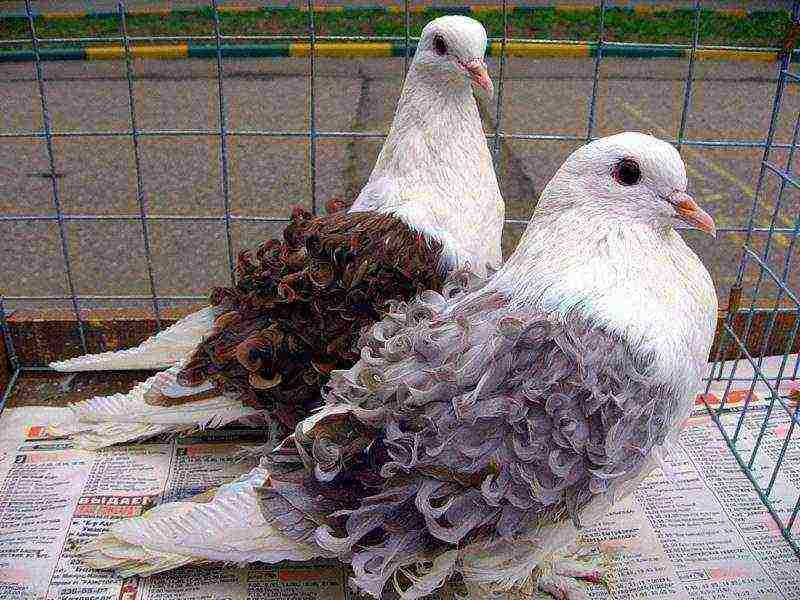
When buying a pair, you should carefully examine the spread wings of birds for the detection of feather mites. Weak, lethargic, sick and infected individuals are immediately discarded.
Bird nesting
In domestic pigeons, the breeding process usually begins at the very beginning of spring.
After the pairs have been identified, it is time to start preparing the nesting process, the task of which is to create the most comfortable conditions for the birds for the birth of offspring.
For wild pigeons, attach large, sprawling branches that resemble a piece of wildlife in the dovecote, since these birds usually build nests in trees.
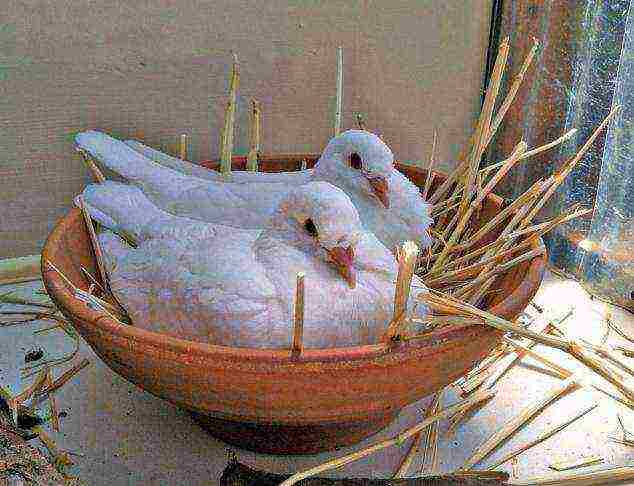
Domestic pigeons, as a rule, arrange nests in hollows, therefore, in order to form an egg clutch, baskets, boxes or boxes made of natural materials should be prepared in advance and placed in different places (far from each other) so that the birds have the opportunity to retire.
As the main raw material for equipping the nest, small thin twigs are suitable, which should be spread throughout the dovecote. The birds themselves will make nests out of them, and only the female will be engaged in this difficult task. The task of the male individual is to provide the construction with the necessary materials, therefore, in addition to branches, dry leaves, dead grass, remnants of feathers and trimmings of woolen threads should be added to the birds.
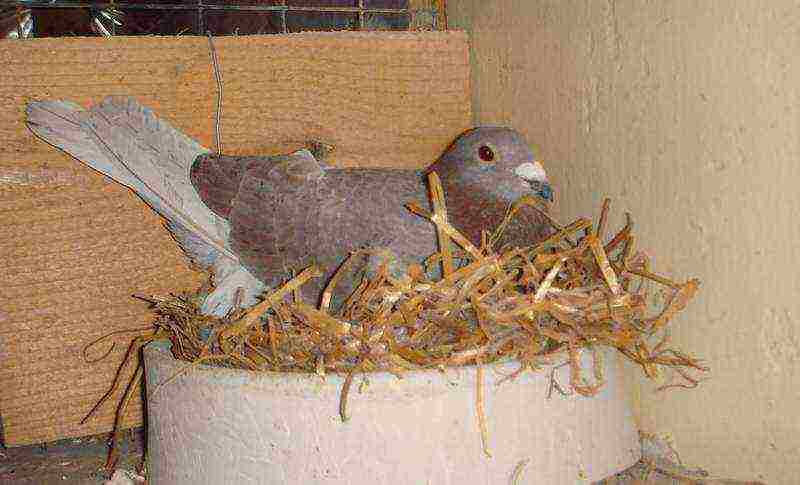
Incubation period
About a week after mating, the pigeons begin an incubation period of about nine days, in which the female lays a couple of eggs at intervals of one and a half days. And here it is important to take into account one nuance: in order to get full and healthy offspring, it is necessary to ensure that the female incubates two eggs at the same time. Therefore, as soon as the first appears, it must be replaced with an artificial or marked egg from another pigeon, and the fresh one must be carefully removed and put in a warm, dark and secluded place. As soon as the second egg appears, the first must be immediately returned to its place, and the substitution must be removed.
It is advisable to check the eggs to make sure they are fertile.To do this, just look through them at a bright source of color (the embryo will look like a black dot with veins around).
Hatching of offspring is carried out by both the male and the female in turn, giving the mate an opportunity to rest and eat.
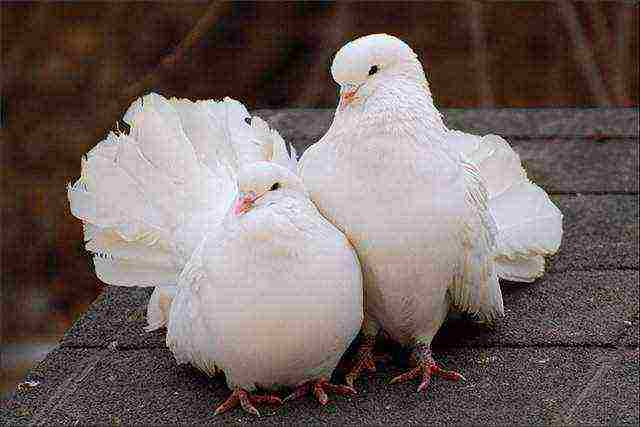
On average, the process of incubating eggs takes about a month.
Caring for chicks
Chicks are born blind, without feathers and at first their parents are engaged in feeding them, but as soon as the young are ready to feed on their own, they should be provided with a high-calorie diet, not forgetting about fresh clean water.
It should be borne in mind that the growing chicks are very voracious and can eat more adults, which is the norm.

The basis of the menu should be cereals, and limestone or crumbled chalk should be given as a supplement to the birds.
Diet of adult birds
The basis of the pigeon's diet should be barley, vegetables and fruits (for example, carrots, apples, potatoes). It is desirable that the average daily feed dosage per bird is about fifty grams.
When feeding pigeons for meat, it is advisable to add boiled eggs and finely chopped pea grains to their diet.

To maintain the elasticity of plumage in birds, they are usually fed with rapeseed and flaxseed, which contain many vitamins.
Do not forget about clean water in drinking bowls.
Caring for pigeons in the warm season
In the summer period, there are no special problems with keeping birds, since pigeons go for a walk in their free summer from the very morning, returning to the pigeon house only in the evening to spend the night.
The attitude to domestic pigeons has been special at all times. According to legend, even the god of war in Roman mythology resigned himself to the dove - she made a nest in Ares' helmet, and he, not daring to disturb the young mother, canceled the war.

Pigeon loyalty is also known to everyone. Pigeons are completely devoted to their half. The only exception can be the death of one of the members of the pigeon family.
It is important that each pigeon in the flock has its own dove, otherwise it may fly away from your dovecote in search of its only one. Always handle the bird carefully and calmly, do not make sudden movements, do not wave your hands, do not raise your voice.
How to build a dovecote and where to place it?
It is very important to choose a suitable location for your dovecote. It should be placed away from high-rise buildings (residents may not like that domestic pigeons sit on windowsills and balconies and pollute them), tall trees, telegraph, telephone and electrical wires - they will interfere with the takeoff and landing of birds. There should be no dumps, cesspools, stables nearby - they can become sources of parasitic and infectious diseases of pigeons.

A dovecote can be made from a large container, sheathed with boards from the inside and insulated with thick cardboard. In the dovecote, in addition to the door, there must be windows - the birds need daylight. Place wooden nests in the form of a large lattice on the walls, insert a cardboard box into each cell, put paper on the bottom.
This design allows you to maintain cleanliness in every impromptu room. You just need to take out the box, clean it, replace the paper and put it back in place. That's the whole cleaning.
Remember that domestic pigeons live in pairs, so the box for each pigeon family should be at least 45 centimeters long and 30 centimeters high.
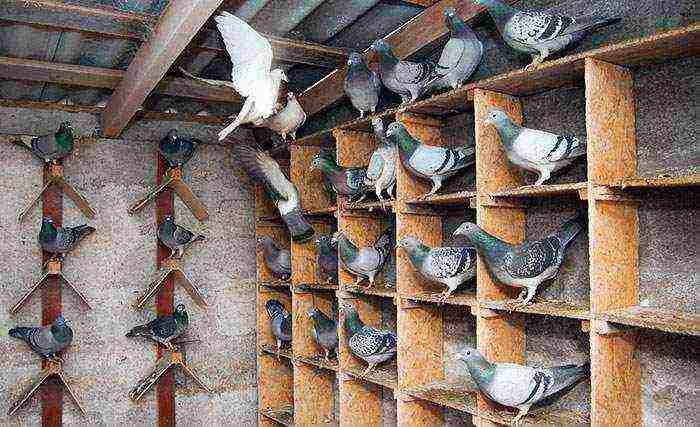
On the roof of the dovecote, make a walk in the form of an open-air cage - a chain-link. The entrance to the aviary from the dovecote should always be open, except on very cold snowy and rainy days.
How to feed pigeons at home?
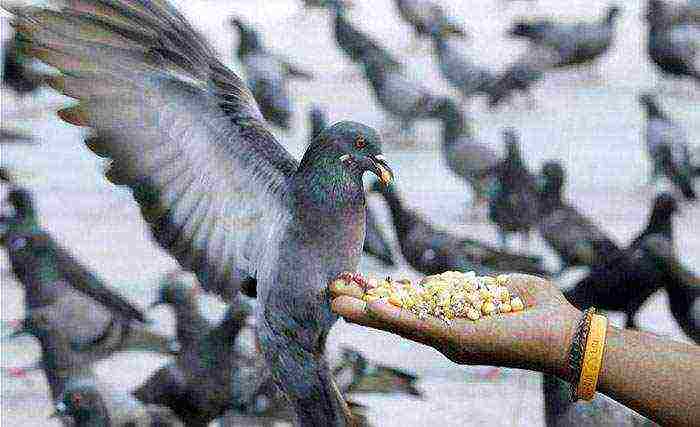
Feed the pigeons 2 times a day so that they eat the food without leaving any residue. An adult pigeon needs 30 - 60 grams of feed per day.It is best to use a grain mixture consisting of wheat or corn (40%), millet or barley (40%), and legumes (peas, vetch, lentils (20%)).
You can make potato-grain mixtures. To do this, peel the potatoes, boil, mash and add grain to it. For pigeons, oilseeds (rapeseed, flax, hemp, sunflower) are a delicacy. They should be given to birds 2 - 3 times a week in small quantities. It is not recommended to give rye to pigeons, as it can cause indigestion.
Domestic pigeons often get sick from malnutrition and may even die. For prevention, include in their diet finely chopped carrots, cabbage, green onions, radish leaves, spinach, lettuce, wood lice, dandelion, clover and other herbs, millet, corn, grated apples.
Pigeons need mineral supplements for the formation of bones, feathers, and egg shells. They also help grind and digest grain feed. As a mineral supplement, use coarse river sand with pebbles and shell rock, crushed brick, chalk, clay, bone meal, crushed and pre-boiled eggshells.
Pour this mixture with water, make sausages or lumps from the resulting mass, dry them in the oven or in the sun and store in a dry place. Crush the lumps as needed and serve the pigeons in a separate bowl. Mineral supplements should be given to pigeons constantly.
Pigeons must have fresh, clean drinking water at all times. Its temperature should not be lower than 10 - 15 ° С. You can make a drinker from a three-liter jar. Pour water into it, close the plastic lid with holes and place it upside down in a container with high sides. The water will pour out of the can as the pigeons drink it. A drinker of this design is convenient because the birds do not spill water.
In winter, pigeons need vitamins. They are inexpensive and the packaging lasts for a long time. Vitamins can be purchased at any pet store.
The food should not be scattered on the floor of the walk - pigeons will contaminate it. Feed pigeons only in a plastic, porcelain or glass feeder. After feeding, remove the feeder - this will teach the birds to eat at a certain time.
Hygiene of domestic pigeons
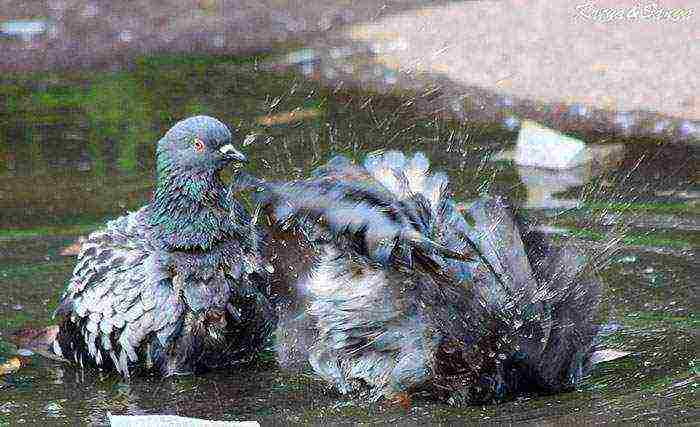
To keep the pigeons clean and tidy, they need to be washed periodically. Pigeons are very fond of water procedures, so bathing will be pleasant and useful for your pets. After bathing, place the pigeon in a box or box to avoid colds and hypothermia.
Set aside a tub for the pigeons that can be placed in the yard around the house. In summer, especially on hot days, pigeons will regularly bathe in the makeshift pool.
Walk the birds regularly, but be sure to keep your pets from being attacked by cats or birds of prey.
Diseases of domestic pigeons
Unfortunately, pigeons often die from various infections. Pay attention to the behavior of your pets - if the bird is behaving unnaturally, it may not be healthy. If a pigeon is huddled in a corner, ruffled, does not eat or drink, sound the alarm. Do not start treatment without consulting your veterinarian.
If the bird has green liquid stools, it means that it has become infected with parasites. Without proper treatment, a sick pigeon quickly loses strength, weight and dies.
Newcastle disease is caused by paralysis of the cerebral cortex. The sick bird rotates rapidly around its axis.
Marek's disease is an infectious disease that manifests itself as bumps under the wings. This disease affects pigeons up to 1 year old.
Loringotracheitis is airborne. Sick birds sneeze and wheeze.
In order not to become infected with other inhabitants of the dovecote, sick birds must be isolated. If you purchase new pigeons, they must be kept separate from other birds (in quarantine) for at least 20 days.
If you notice that a bird sits, crumpled, with lowered wings and closed eyes, refuses to feed, then this is a clear sign of its ill health. Also a sign of the disease is liquid, sometimes slimy, watery, light yellow or green droppings with an unpleasant odor (the droppings of healthy pigeons are pasty, gray-brown in color).
If you have any suspicions about the health of the bird, seek the advice of an experienced fancier or veterinarian.
How to tame a pigeon

If you need to catch a pigeon close the windows - in the dark, pigeons do not see well and are calmly given in hand. Catch the pigeon from above behind the back, then shifting so that its feet are between the index and middle fingers. Treat the bird calmly and affectionately, then it will quickly become tame, get used to you, will not be afraid, will sit on your shoulders, take food directly from your hands.
It is better to teach a pigeon to return home not in a city apartment, but in a special dovecote. You can try to release the pigeon on the balcony, after tying its wings, and give it the opportunity to walk like this for several days.
You need to release the pigeon hungry, and before the end of the walk, pour some food on the floor so that the pigeon comes on its own, and you can safely take it.
After such a training, you can try to release a domestic pigeon, but most likely he will not return, but will look for a mate. Therefore, in dovecotes, pigeons are first mated, allowed to occupy the nest and lay eggs, and only after that they are released to walk on the roof.
If you have pigeon houses in the area, show them your pet. Perhaps they will help you train him or, if you deem it possible, they will take the bird to their dovecote. An experienced pigeon breeder will surely take the best possible care of the bird.
Of course, there are many worries when keeping domestic pigeons, but the result is amazing. When communicating with pigeons, observing their behavior, your mental state will improve, you will receive vitality and positive emotions.
On the contrary, if you have too much energy, you are prone to stress, have a tendency to hysteria and depression, pigeon cooing will calm you down and normalize your psychological state. It is enough just to pick up a domestic pigeon, feed the flock or just watch them, and anxiety, fears, bad mood will pass without a trace.
Many people like graceful pigeons. Some are simply in love with them: poultry farmers are ready to spend their last money on equipping a beautiful and reliable pigeon house, choosing the right diet and keeping birds. What is the beauty of these cute creatures, what breeds are there for breeding, and what are the advantages of this kind of hobby? Read on.
How to breed at home?
Breeding pigeons at home is not a hobby, but the love of a lifetime. Graceful birds are not aggressive, they treat people perfectly and carefully - it is not for nothing that they deservedly received the title of a bird symbolizing peace all over the world. Our poultry farmer knows them from the movie, which has already become a classic: despite the exaggerated idea of man's love for birds, it is almost impossible to breed pigeons at home and not love them.
A novice amateur poultry breeder should prepare not only for contemplation of the beautiful, breeding pigeons at home, but also for hard but pleasant work. Initially, it is worth equipping a dovecote, convenient for bird life. If you do not arrange comfortable housing for them, the birds will be uncomfortable, and there will be no question of breeding.
It is especially necessary to carefully approach the choice of the breed, the selection of a suitable diet. Some pigeons can live alone, but the vast majority are best kept in pairs.Then you can read about all the necessary preparations before breeding birds at home, see interesting videos with instructions for keeping and get recommendations on choosing a breed and caring for small chicks.
Choosing a breed
The keeping of pigeons and its complexity depends to a large extent on the chosen breed. Initially, you should think about what kind of pigeons you want to breed: domestic or wild. The latter are considered more fastidious, caring for wild-looking pigeons will require large physical, material and moral costs from you. They are especially sensitive to the correct arrangement of the dovecote, feeding, and free space. Since these birds are not fully domesticated, they are used to living in freedom and staying in a spacious dovecote, but still locked up for them, is a huge stress.
Loading …
Domestic pigeons, on the other hand, are considered very easy to keep and breed. The preparatory process will give you more trouble than breeding or caring for birds. Initially, it is worth deciding on the breed of domestic pigeons, of which there are a large number, depending on the size, plumage and other characteristics. Let's try to distinguish three main types of domestic pigeons, depending on the purpose of their breeding.
Domestic pigeons can be of the following types:
- Flight breeds. Such birds are bred to demonstrate a beautiful flight. Poultry breeders compete in which of the birds will have the most beautiful flight. Surprisingly, the breeds of such birds are distinguished by their flight pattern - this is their distinctive feature.
- Sports breeds. At home, it is possible to breed pigeons in order to participate in competitions. Such pigeons are descendants of ancient carrier pigeons that flew hundreds of kilometers, carrying important messages to the addressee. Today's postal, they are also sports, pigeons do not fly that far, however, in competitions of this type, the one who flies farther or faster wins.
- Decorative birds. Keeping pigeons for beautiful plumage or unusual color is not uncommon. For this, special species of birds are acquired, for which international standards of appearance have been developed. You will be able to participate in exhibitions, proving that it is you who grow the most beautiful and sleek birds. Caring for decorative pigeons is quite difficult, you need to especially carefully monitor their conditions of detention.
Before choosing a particular breed, it is better to study in advance the information about the features of the content: they can differ significantly. In the meantime, you can enjoy the beautiful decorative pigeons on the video. Maybe you want to buy yourself just such?
We select pairs for breeding
Pigeons usually breed in the spring. Experienced poultry farmers know: you need to prepare for it in advance. If you breed pigeons at home solely for the purpose of aesthetic pleasure and peace of mind, then you may not specifically select a pair. Pigeons will naturally choose mates and nest with them.
If it is necessary to observe the clean plumage of a certain color, show characteristics of the brood, it is worth choosing partners and artificially pairing pigeons. For the very novice poultry farmers, here are some tips for identifying the male and female. The male is larger, he will be the first to start caring for his future partner, increasing the goiter, will perform a kind of mating dance.
When choosing a female for artificial breeding, rely on birds of average build. If the hen is overweight, this will negatively affect the eggs and offspring: there will be problems with laying, the process will be difficult for the bird itself. A thin build, on the contrary, will not allow eggs to hatch.The best choice is birds of medium build, outwardly healthy male and female, with excellent appetite and breed characteristics (flying - good flight, athletic - endurance, and so on).
Another advantage of self-breeding of these birds at home is the possibility of selection. You can choose from different plumages and colors and keep track of which chicks will appear - many breeds were bred in this way of artificial mating. The results can be recorded in a special journal.
Having made a bet on artificial steaming, it is necessary to take care of the so-called steam box in advance. It should be separate from the dovecote, if there are several of them, and there is little space in the dovecote, it can be one structure, with divided sections for each pair. Once you have chosen your ideal breeding partners, leave them in such a box overnight. Usually, during this time, the birds have time to understand whether a partner is suitable for them or not. You will see their predisposition to each other the next day: the successfully formed couple will spend all the time together.
Nesting
The pairs are matched, it's time to start preparing for the nesting of birds. At this stage, the poultry farmer has a responsible mission: to bring the nesting conditions of birds as close as possible to their natural habitat. What does it mean? Choosing to breed wild pigeons, it is worth thinking about light wire frames or large tree branches that will remind them of wildlife, where they build nests on tree branches or in abandoned habitats of other animals.
Domesticated pigeons prefer to build nests in hollows, so wicker baskets and boxes made of natural materials, wooden boxes are suitable for laying eggs. The size should be selected individually: the box is larger for large individuals, smaller for small birds. The ideal option would be to arrange the boxes far from each other: couples like to feel alone, it will be easier for them to recognize their own box if they are not knocked down by the smells of nearby dwellings. Pigeons can distinguish shades, so you can paint future nesting sites in different contrasting colors.
Next, it is worth taking care of the material from which the nests will curl. There is nothing unusual here: it is better to choose small natural twigs, scattering them throughout the dovecote. The couple will look for those that are suitable for themselves and bring them to the nest. By the way, an interesting fact: only females are engaged in arranging the nest, while their partners simply help them by providing them with the necessary material. Dry grass or leaves can be added to the nesting material; for large individuals, larger branches can be taken. The video shows the process of building nesting sites in more detail.
Incubation period
The incubation period in pigeons takes up to nine days on average. The female lays a couple of eggs at intervals of one and a half days. This happens a week after the pair has mated. It is important that if you want to get healthy offspring, you need to make sure that the female begins to incubate two eggs at the same time.
How to do it? As soon as you see that the bird has laid one egg, carefully, so as not to damage the shell, remove it from the nest and move it to a dark, warm place. Then replace with an artificial egg or a tagged one, but from another pigeon. When the female lays the second, you can return the real egg.
After the female has begun to hatch, the eggs should be checked. After three to four days, check each one for light: the future chick will already declare itself a black dot with a pattern in the form of veins. If the spring is too hot for incubation, by the end of the incubation period (15-20 days) moisten the lower part of the nest with plain water: this will soften the shell and facilitate the emergence of chicks. The pigeons themselves will say about the appearance of the babies when they throw the shell out of the nest, leaving more room for the offspring.
The birth of chicks and their care
Chicks are born blind, they often have no plumage in places or completely. The first days of life, their parents feed them with pre-processed food from their beak. After the first week, poultry farmers need to accustom the babies to the feeder, many use special feeders, which they put babies with.
Once the chicks are ready to self-feed, they need to provide them with a consistent and stable diet. It is worth feeding the birds twice a day; you must not skip the food service. Constantly change the water in the drinkers, make sure that the individuals always have access to them. When the period of rapid growth comes, small pigeons may eat even more adults - this is normal. At this time, the diet should be enriched with vitamins and be as varied as possible.
Requirements for keeping birds
These birds are not particularly whimsical in choosing a diet. The basis of the menu should be cereals, it is also worth adding mineral dressing in the form of limestone or crushed chalk. If you breed birds for business purposes, then it is better to rely on a ready-made, selected diet - it contains all the necessary minerals and trace elements for the rapid and high-quality growth of birds.
You can breed birds in aviaries or in a specially equipped dovecote. It is easier to build an aviary, but great requirements for disinfection are put forward to its content. You will also need to carefully prepare the aviary before nesting. It is better to build a dovecote in advance with ready-made paired boxes and feeders. Disinfect regularly, monitor the isolation of sick individuals. The rest of the birds are unpretentious in care.
Room preparation
Before breeding birds, it is necessary to provide them with proper care. At home, you can and should disinfect the pigeon house. Previously, many used a solution of potassium permanganate, mixed different amounts of slaked lime and caustic soda in a certain proportion for disinfection. Today there is no need to resort to such tricks: you can buy a ready-made disinfection solution in a specialized store.
This way you will know for sure that your pigeons are safe. It is necessary to carry out such cleaning for the purpose of prevention twice a year and after one case of infection of an individual with an infectious disease. Processing the premises will avoid contamination with salmonella, pseudo-plague and other ailments.
Do not forget to isolate the birds from contact with harmful chemicals during disinfection; it is better to process the dovecote in such a way that the birds do not even breathe in vapors of harmful substances. Cleaning is carried out without bedding, everything is processed - nests, walls and floors of the dovecote. You can use the thermal effect of a blowtorch.
Sanitation standards
A few simple rules will help keep the pigeon house clean and get a healthy population of birds:
- Once a week or several times, it is worthwhile to cleanly wash and disinfect the feeder so that harmful bacteria and microorganisms will not accumulate in it.
- Make sure that rats and other rodents do not enter the dovecote: clean the feeders of feed after serving food. Animals can infect and infect birds.
- In one dovecote, it is not worth keeping more than twenty individuals, if there are more of them: divide the room into sections.
- Walls from the north and east should be isolated from drafts; it is better to use plywood for this. The floor is being concreted.
- You need to regularly disinfect the pigeon house with special solutions.
Video recording "Pigeons: where did it all begin?"
In the video, an experienced poultry farmer will tell you how his love for these graceful birds began. The information will be of interest to both experienced bird breeders and beginners.
